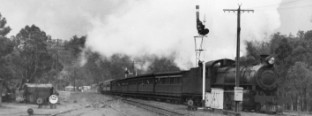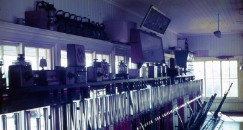Block Theory
ABSOLUTE BLOCK WORKING in Western Australia
History and Theory
The intention of Absolute Block Working on railways came about following a number of tragic railway crashes in England and other countries during the early days of railways. In these early days, trains were despatched from a station according to a published time table with no means of checking whether they had arrived at the destination. This system was called the Time Interval system. Whilst trains were few and distances were short, this could work, but it did not take into account the very real possiblity of train failures (breakdowns) or other accidents. A better form of working was desperately needed if the safety and confidence of the travelling public and workers alike was to be guaranteed.
During the formative years of railways, great strides were being made in other areas of science, and one of these was in the area of communication over distances. This involved the use of telegraphy. Indeed, it was the combination of the fields of Telegraphy and Railway Signalling that revolutionised railway working and these two disciplines formed the basis of railway 'safe working' (these days known as 'Safeworking') and still ensure the safety of passenger and employees to this day Thanks to this, the railway could be divided into Blocks - initially a 'block' was the line (also called a 'Section') between two adjacent railway stations. The Signalman at one station was required to 'apply' for permission to send a train to the next station, and when the permission was given the train would be despatched. Only when the train arrived at the next station would the Signalman there advise the Signalman at the first station that it had arrived and then another could be 'offered'. Where the distance between stations was too long, a signal box (or boxes) could be provided to form a Block Post in essence to reduce the time taken for a train to reach a safe dividing distance - this became known as 'headway'.
Alongside Telegraphy, Telephony also became available, and soon it too became inextricably linked to other railway systems to provide reliable, safe communication.
Sadly however, even with these advances, mistakes still occured and tragic accidents again resulted. After each of these disasters, the authorities investigated the cause of each as rigorously as possibly for the era, and new railway operating rules were instituted, and where possible, combined with advancements in the emerging technology of the time to provide a safer system.
Early systems of railway telegraphic equipment used in this state required the operator to 'spell out' their requirements using the handle of an instrument at one station which operated the position of a needle on a dial on the other instrument at the far station. Although the operators became proficient at using these systems, they soon became cumbersome and out-dated as new developments became available. New manufacturers made similar systems, based on the original concept, and the Western Australian Government Railways (W. A. G. R.) made use of several of these manufacturer's products over the history of railways in this state.
The basic object of the Block Telegraph System of railway signalling is to ensure that that only one train can be in the 'section' between two adjacent Block Stations on the same line, at the same time.
The last of the WAGR Rule Books to carry instructions about the Block Telegraph System(s) was the 1962 Book of Rules, and note in Rule 283 states:
"In a block system of train signalling an instrument known as a block instrument is provided in the signal-box at each end of the section. The block instruments are inter-connected and record the train working signals sent and received and thus give a constant indication to the Signalman of the conditions of the section to which they apply."
Rule 283 itself cautioned that:
"The signalling of trains on the block telegraph system does not relieve any person of the obligation of using fixed, hand, or detonating signals, whenever and wherever those signals may be necessary." (This author believes that the additional text should have been added to the end of that sentence - 'in order to protect trains'.)
Single Line Block Working
Working of trains along single lines of railway between two adjacent stations also demanded a high level of protection and for those lines as in addition to preventing more than one train in a section there needed to protection to stop train meeting 'head-on in the section.
The Train Staff and Ticket System was used over sections where the trains were infrequent and or traffic density was low. The basic concept was that a Train Driver was required to carry with him on the locomotive an 'Authority to be in the Section'. This took the form of a Staff (typically a wooden baton, later fitted with a brass sheath having nibs that acted as the 'key' to the Staff Boxes located at each end of the section). This method of working was flexible enough for most traffic working situations. As, if two or more trains were required to travel in the same direction through a section before a train was required to return from the opposite direction the first trains travelled on a 'Ticket' and the final train carried the 'Staff' in readiness for it to be at the correct end of the section for the next returning train. This system did not require electrical interconnection.
The Electric Staff system of working was introduced for lines that had a lot of rail traffic and where the traffic frequency, or density was high. This system was electrically interconnected and enabled the withdrawal of a 'Staff' from the instrument at either end of the section, provided a Staff had not already been withdrawn. As there were multiple Staffs in each instrument, but locked in such a way as to prevent only one being withdrawn at a time, this proved to be a very safe and reliable method of train working provided of course that the applicable Rules governing its use were followed correctly. Two types of instruments were used in Western Australia - Large and Miniature.
Each of the systems of block telegraph used by the WAGR used Bell Codes. These bell codes were as one might expect, an audible system of codes which related to an action or passed a message between Signalmen more rapidly than watching the deflection and translation of a telegraphic needle, and each was enshrined in its own Rule.
The different Block systems used in Western Australia were:
Alphabetical Instruments (Siemens & Halske)
2 Position Block (Winters)
3 Position Block (Dowson's)
Lock and Block (Sykes)
Staff and Ticket Working
Electric Staff and Ticket Working (Railway Signal Co)
Electric Staff Working
and their Bell Codes


